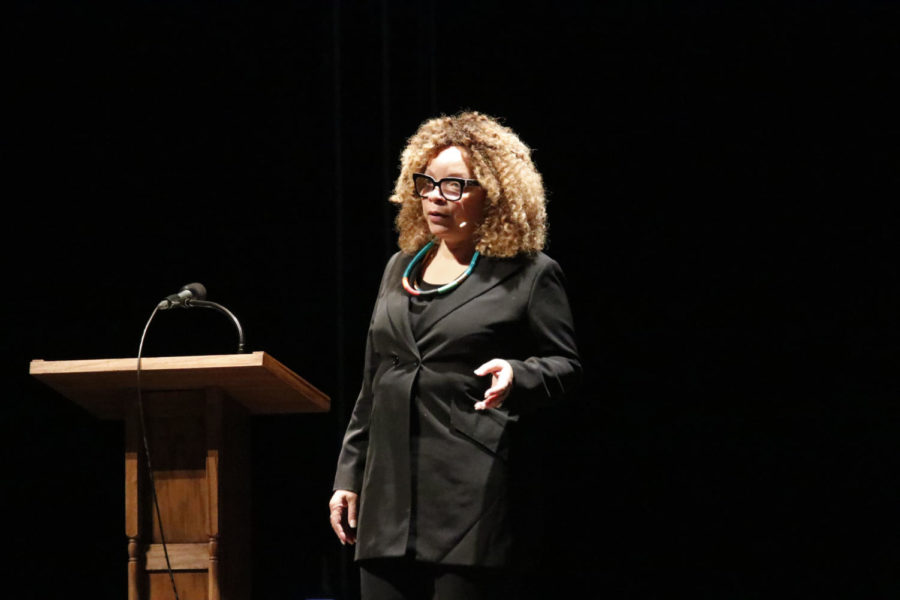- Limelight
- Limelight / Culture
- Limelight / Culture / Campus Culture
- Limelight / Events
- Limelight / Visual Media
- Limelight / Visual Media / Film
Ruth E. Carter shares the story of ‘Black Panther’ with ISU
Gillian Holte/Iowa State Daily
Costume designer Ruth E. Carter spoke in Stephens Auditorium on Oct. 9. Carter mentioned designing costumes for superheros for the first time. “I use a lot of the same principles that I use for developing characters and coming up with their stories. I am very specific about who they are and how they look when I approach the work of black panther,” Carter said.
October 10, 2018
Costume design became world design when Ruth E. Carter worked on Marvel’s blockbuster superhero film “Black Panther.” The Oscar-nominated costume designer showed off a wealthy amount of detail for over a thousand costumes she created for the world of Wakanda during her lecture at Stephens Auditorium on Monday night.
The world Carter built for “Black Panther” with her costumes required intense research. The eight tribes which exist in “Black Panther’s” fictional country of Wakanda all take inspiration from real African people. Carter said while working on the film the designers had the idea the entire continent of Africa could have stemmed from Wakanda, so she tried to include as much detail as she could in her costumes from real African tribes.
“It was important to be geographically correct, historically correct, and give it a place in time that was the future so people could relate to it,” Carter said.
Each of the eight Wakandan tribes all received their own palette of colors, clothing and jewelry, making each tribe truly stand out. This has a major impact on the visual appeal of the film.
“We see all of this interesting color and interesting vibe and we coordinate all of these looks that you see when you see people passing by,” said Carter during the lecture.
Carter worked with her own team of designers and also with Marvel Studios’ visual development team on the film. Certain things the studio had to be more hands on with than others, mainly any costumes a character would be fighting in. Carter explained in her lecture some of her ideas were rejected by Marvel. However, Carter said Marvel Studios doesn’t have a strict environment and the freedom to create is very much there.
“Films like ‘Black Panther’ do not get the level of artistry that they have based on one person’s idea,” Carter said. “They’re based on many ideas that come together to perfect something. They take an idea from one level and bring it to the next level. Then it’s scrutinized by a group of creatives, and it’s not necessarily scrutinized for what’s wrong with it, it’s sometimes scrutinized for where it could be better.”
Carter said Marvel Studios didn’t want the designers to feel limited in their creativity. Many elements of “Black Panther” started out as bigger ideas from the studio to kickstart development before being handed off to designers to fine-tune them.
Carter is known for her work in historical and biographical films such as “Selma” and “Malcolm X.” Carter got her first foray into the blockbuster superhero movie genre with “Black Panther.”
“The budgets gets bigger but in comparison to what you need to get done they’re all the same,” Carter said. “We are dealing with no more time frame then we would on a smaller film and we have a whole lot more to get done. … There were multiple streams happening at the same time that were extremely expensive and I still had to rely on the same skill set used on all my other films.”
Outside of her department, Carter heavily collaborated with director, Ryan Coogler, production designer, Hannah Beachler, and director of photography, Rachel Morrison.
“We used a lot of blue screen and green screen so it was imperative that I know what the design looked like on paper because, when the costumes got to set, I was not going to see anything but the costumes,” Carter said. “The rest of [the set] was a stair-step, that would lead to what eventually in post production would be a talon fighter, and everything after that a huge area of blue [screen]. In working with them, we were very clear about our set.”
Carter described “Black Panther” as highly collaborative, highly creative and an inspiring effort.
“It was really creating a world. Creating a world that is made up,” Carter said. “We were kind of like the elder council of this creative environment that was producing something bigger than life itself.”







